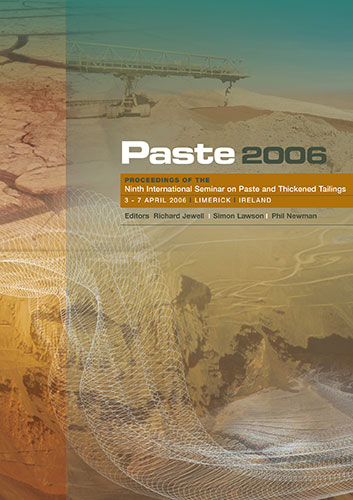Rheology Control of Thickened Tailings and Paste Pumping Systems

|
Authors: Paterson, AJC |
DOI https://doi.org/10.36487/ACG_repo/663_5
Cite As:
Paterson, AJC 2006, 'Rheology Control of Thickened Tailings and Paste Pumping Systems', in R Jewell, S Lawson & P Newman (eds), Paste 2006: Proceedings of the Ninth International Seminar on Paste and Thickened Tailings, Australian Centre for Geomechanics, Perth, pp. 47-56, https://doi.org/10.36487/ACG_repo/663_5
Abstract:
Thickened and paste tailings typically exhibit non-Newtonian characteristics. It is well established that the viscous properties of these slurries are dependent on a wide range of parameters, including particle size distribution, solids concentration, pH and water chemistry. However, many systems are still designed assuming a constant rheology, and operating conditions are specified in terms of slurry density. At low solids concentrations this is acceptable as the effects of changes in solids concentration on rheology are relatively small. As solids concentration increases, small increments have a significant impact on rheology. Designing for a constant solids concentration or density implies (unrealistically) that the ore body will be uniform throughout the mine life and results in systems that are not sufficiently flexible to accommodate the wide fluctuations in rheology that will occur. This paper presents an alternative methodology that assumes that solids concentration will vary naturally as physical properties change, and that rheology is the key driver to ensure a reliable, and integrated, system design. The benefits are numerous, including improved thickener control, optimum pumping system design, and obtaining consistent deposition and beaching angles.
References:
Slatter, P.T. and Wasp, E.J. (2000) The laminar/turbulent transition in large pipes, 10th International Conference on Transport and
Sedimentation of Solid Particles, Wroclaw, 4-7 September 2000, ISBN 83-87866-12-1, pp. 389-399.
56 Paste2006,Limerick,Ireland
RheologyControlofThickenedTailingsandPastePumpingSystems A.J.C.Paterson
© Copyright 2025, Australian Centre for Geomechanics (ACG), The University of Western Australia. All rights reserved.
View copyright/legal information
Please direct any queries or error reports to repository-acg@uwa.edu.au
View copyright/legal information
Please direct any queries or error reports to repository-acg@uwa.edu.au